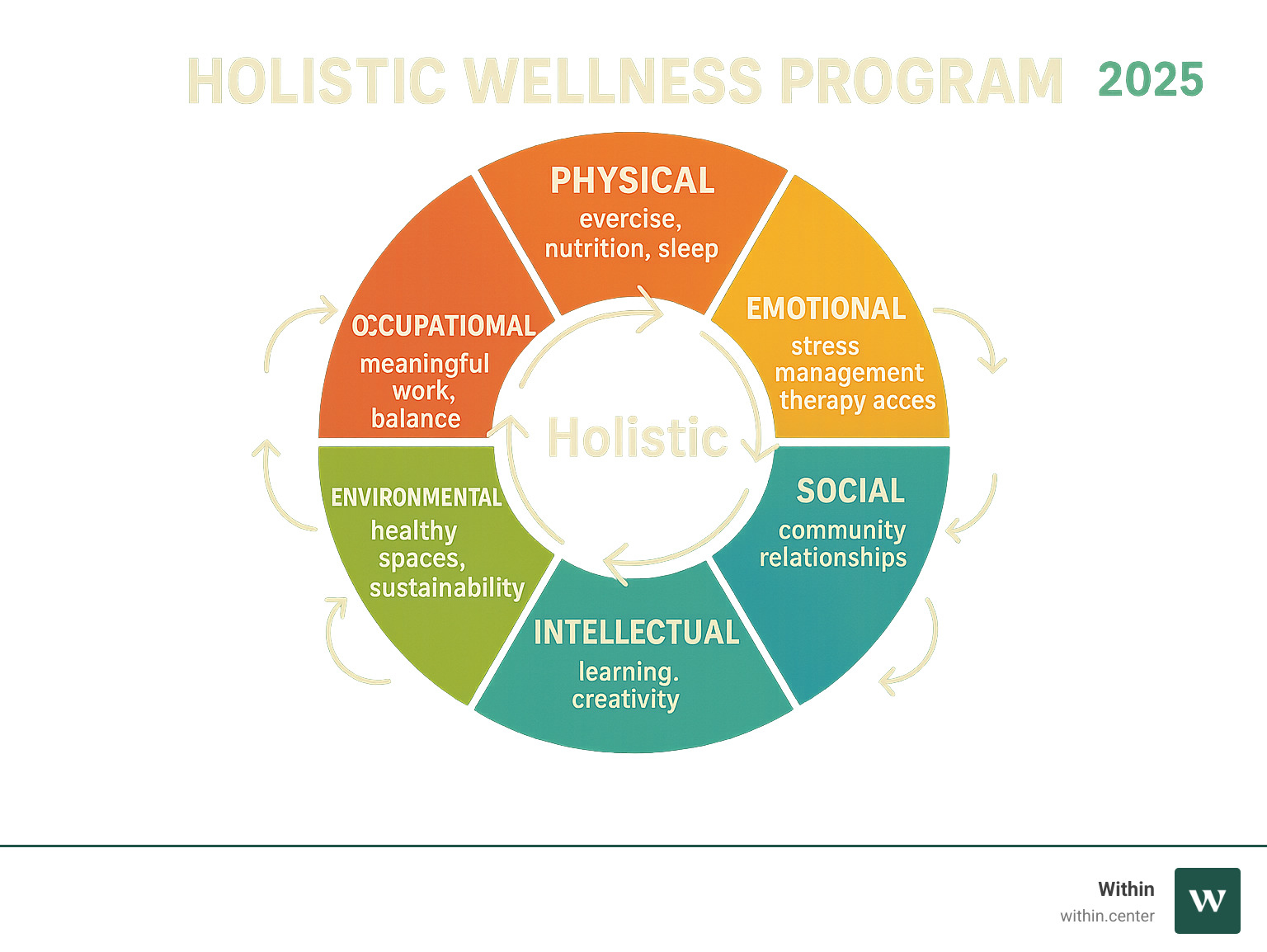A holistic wellness program goes beyond traditional gym memberships and health screenings to address every dimension of well-being, from physical and mental health to financial security and spiritual fulfillment.
Key Components of Holistic Wellness Programs:
- Physical wellness – fitness, nutrition, ergonomics, preventive care
- Mental/emotional wellness – stress management, therapy access, mindfulness training
- Social wellness – community building, team activities, relationship support
- Financial wellness – financial planning, debt management, retirement guidance
- Spiritual wellness – purpose alignment, meditation spaces, values exploration
- Intellectual wellness – continuous learning, skill development, creativity support
- Environmental wellness – healthy workspaces, sustainability initiatives
- Occupational wellness – meaningful work, career development, work-life balance
The research is clear: 93% of employees believe wellbeing is as important as their salary, and companies with comprehensive wellness programs see up to 227% ROI for every dollar invested. These programs reduce absenteeism by 1.5-1.7 days per employee annually while cutting healthcare costs significantly.
Holistic wellness recognizes that everything is connected. Financial stress affects sleep, which in turn impacts emotional regulation and physical health. While traditional programs treat symptoms, holistic programs address root causes.
As one workplace wellness expert noted: “Wellness is not a one-size-fits-all model.” The most effective programs understand that true well-being requires addressing the whole person, not just isolated health metrics.
For individuals struggling with chronic mental health challenges like anxiety, depression, or burnout, workplace holistic wellness programs can provide crucial support and resources that complement personal healing journeys.

What is Holistic Wellness? A Whole-Person Philosophy
True wellness goes beyond hitting the gym or eating a salad. A holistic wellness program is built on the understanding that every part of our well-being is connected. This approach views our physical, mental, emotional, social, financial, spiritual, intellectual, environmental, and occupational dimensions are deeply woven together. Damage to one area affects the whole.
This approach is proactive, building resilience from the ground up rather than just treating symptoms after problems arise. At Within, we deeply understand this interconnected approach to healing. As we explore in our article on The Future of Healing: How Holistic Modalities and Integrative Therapies Are Changing Mental Health, true change requires looking at the whole person.
Here’s how a holistic wellness program differs from traditional approaches:
| Feature | Traditional Wellness Programs | Holistic Wellness Programs |
| Focus | Gym discounts, annual health screenings, basic health metrics | Multi-dimensional support addressing all aspects of well-being |
| Approach | Reactive – addresses problems after they occur | Proactive – builds resilience and prevents issues |
| Scope | Physical health primarily | Physical, mental, emotional, social, financial, spiritual, intellectual, environmental, and occupational wellness |
| Method | One-size-fits-all solutions | Personalized, flexible programs that adapt to individual needs |
| Support | Limited to physical health resources | Comprehensive resources including mental health, financial literacy, community building |
The Key Pillars of an Integrated Life
Understanding holistic wellness means exploring its key dimensions. We are complex beings who thrive when all parts of our lives are nurtured.
Physical wellness—fitness, nutrition, and sleep—is the foundation. Poor physical health impacts every other area of life, from work performance to emotional balance.
Emotional and mental wellness involves managing stress, building resilience, and having access to mental health support. Research from A study on the importance of community and belonging for health shows how critical this is to our overall health.
Social and community wellness is essential, as we are wired for connection. Building meaningful relationships and a sense of belonging is vital for thriving.
Financial wellness is crucial because financial stress impacts sleep, anxiety, and relationships. A holistic program must include financial literacy and planning support.
Spiritual wellness is about finding meaning and purpose, whether through meditation, nature, or service. It provides the “why” that fuels our well-being.
Intellectual wellness keeps our minds engaged through continuous learning and creativity, contributing to confidence and life fulfillment.
The beauty of holistic wellness lies in how these dimensions support each other. Improving one area, like physical health, often boosts another, like emotional balance. This interconnected approach is what makes holistic wellness so powerful.
The Ripple Effect: Benefits for Individuals and Organizations
Implementing a holistic wellness program creates a ripple effect of benefits for both individuals and the organization. This win-win scenario translates investment in people directly into organizational success.

Let’s look at the organizational benefits:
Reduced absenteeism is an immediate, measurable benefit. Wellness programs can cut sick days by 1.5-1.7 days per employee annually, leading to significant cost savings and productivity gains.
Lower healthcare costs follow naturally. Healthier employees lead to lower healthcare utilization and costs, a powerful financial incentive that makes these programs self-funding.
Increased employee engagement soars when people feel genuinely cared for. They become more invested, creative, and committed, fostering a vibrant workplace culture.
Higher morale and job satisfaction are the natural outcomes. When employees feel valued as whole human beings, they create a positive, contagious energy.
Improved talent attraction and retention is a key advantage in a competitive market. With 81% of employees seeking mental health support, a holistic program is a powerful recruiting and retention tool.
The numbers speak for themselves. A Harvard meta-analysis on wellness program ROI indicates that companies can see up to 227% ROI for every dollar spent. This isn’t just a perk—it’s a strategic business imperative.
How Holistic Wellness Boosts Personal Resilience
Beyond organizational benefits, a holistic wellness program empowers individuals to build deep personal resilience.
Stress management becomes proactive. Holistic programs offer practical tools like mindfulness and therapy access, helping employees actively reduce stress rather than just cope with it.
Improved sleep is fundamental to health. Holistic wellness emphasizes good sleep hygiene and provides resources to improve it, which is a game-changer for cognitive function.
Improved mental clarity emerges when mental and emotional well-being are addressed. This leads to better focus and decision-making, boosting productivity.
Greater sense of purpose develops through engagement with spiritual and occupational wellness. Finding meaning in life and work is linked to better health and lower stress.
Increased energy levels happen naturally when all dimensions of wellness are supported. This includes the mental and emotional vitality that comes from an integrated approach.
True healing and resilience require a comprehensive approach that recognizes how mind, body, and spirit work together. To understand why a singular focus isn’t enough, read more in Why a Multi-Modal Approach is Essential for True Healing.
Designing an Effective Holistic Wellness Program
An effective holistic wellness program isn’t a one-size-fits-all solution. It requires building an authentic program custom to your company’s culture and people’s unique needs.

Securing leadership buy-in is the critical first step. Leaders must champion the program, participate visibly, and integrate wellness into the company’s DNA to show that it’s a true priority.
Assessing employee needs comes next. Don’t assume you know what your people want. Use anonymous surveys and focus groups to understand their real struggles, which transforms a generic program into one that is valued and used.
Customization and flexibility are essential because your workforce is diverse. Offer multiple pathways to well-being that allow employees to choose what’s most relevant to their life stage and needs.
Your communication strategy is vital. Use multiple channels to ensure employees know about the program and how to access it. Appointing wellness champions in different departments can also boost engagement.
The beauty of holistic wellness is how it mirrors comprehensive healing modalities. You can learn more about one such approach in our article on What is Ketamine Therapy?.
Practical Strategies for a Thriving Workplace
Here are some practical ideas for supporting each dimension of wellness:
- Physical: Offer ergonomic assessments, standing desks, and fitness challenges. Provide nutrition workshops and healthy snacks. Encourage at least 150 minutes of moderate exercise weekly, per WHO guidelines on physical activity.
- Mental/Emotional: Provide subscriptions to mindfulness apps, Mental Health First Aid training, and easy access to therapy via EAPs. Create quiet zones for meditation and reflection.
- Social: Foster connection with team volunteering days, book clubs, healthy potlucks, and family-friendly events.
- Financial: Offer workshops on budgeting and investing, access to financial advisors, and retirement planning support to reduce financial stress.
- Intellectual: Promote growth with Lunch & Learn sessions, skill development courses, and educational content like our Going Within Podcast.
Measuring the ROI of Your Holistic Wellness Program
Measuring success helps you understand what’s working and how to improve your holistic wellness program.
- Employee satisfaction surveys: Use surveys to get direct feedback and track changes over time.
- Absenteeism rates: Track absenteeism rates before and after implementation to see the concrete impact.
- Healthcare claims data: Analyze aggregated healthcare claims data for long-term trends, such as decreases in stress-related conditions.
- Retention and turnover rates: Monitor retention and turnover rates, which often improve with strong wellness programs.
- Participation metrics: Use participation metrics to see what’s popular and where you might need to adjust your strategy.
The ROI of wellness extends beyond numbers to improved morale, a stronger culture, and a more resilient workforce.
Overcoming Challenges in Implementation
Implementing a holistic wellness program has its challenges, but each one is an opportunity for improvement and refinement.

Addressing low participation is a common hurdle. It often occurs because employees are too overwhelmed to add another activity. The solution is to integrate wellness into the workday. Offer walking meetings, provide healthy snacks, or create quiet spaces for breaks. Make participation easy and accessible, not another burden.
Budgeting for wellness can be a sticking point, but many impactful initiatives are low-cost. Start small with things like a designated quiet room, flexible work arrangements, or peer support groups.
Gaining leadership support is crucial. Present a clear business case with data on ROI, reduced absenteeism, and improved retention. Emphasize that wellness is a strategic initiative for creating a high-performing workplace.
Catering to a diverse and remote workforce requires a flexible approach. A one-size-fits-all program fails here. The key is to offer a variety of options that meet different needs and work situations.
The Critical Role of Leadership in Fostering a Wellness Culture
The most successful holistic wellness programs have leaders who don’t just approve them, but live them.
Leading by example is key. When leaders are authentic about their own wellness journey—like taking a mental health day—it signals that prioritizing well-being is respected and encouraged.
Creating psychological safety is perhaps the most important role of a leader. This means fostering an environment where employees feel safe discussing challenges and where asking for help is seen as a sign of strength.
Allocating resources consistently shows that wellness is an ongoing commitment, not a one-time project. This includes time, money, and personnel.
Integrating wellness into company values transforms it from a perk into a core part of the culture. It becomes embedded in the company’s mission and daily operations.
At Within, we’ve seen how strong, compassionate leadership guides people toward genuine well-being. Our team embodies this commitment. You can learn more about the people behind our mission at Our Team.
Frequently Asked Questions about Holistic Wellness Programs
Here are answers to the most common questions organizations have about implementing a holistic wellness program.
How much does a holistic wellness program cost?
Costs are scalable. You can start with free initiatives like walking challenges or healthy potlucks. More comprehensive programs might include mental health coverage or premium wellness retreats. A good strategy is to start small and scaling up, perhaps with mindfulness app subscriptions ($5-15 per employee monthly) and then adding more components over time. The key is to focus on the ROI. With returns of up to 227%, the savings from reduced absenteeism and higher retention often far outweigh the program costs.
How do you get employees to participate?
Start by asking employees what they need through surveys or focus groups. Involve them in the planning to create ownership. Ensure leadership participates to signal its importance. Finally, make activities accessible, rewarding, and genuinely enjoyable, not another chore. When a program feels like a helpful break rather than homework, participation will follow.
Can a holistic program work for a small business?
Absolutely. Small businesses can be nimble and should focus on high-impact, low-cost initiatives. An Employee Assistance Program (EAP) offers comprehensive support for a low per-employee cost. Flexibility in work hours or location is a powerful, free benefit. You can also partner with local businesses for discounts or workshops. A successful program is about genuine commitment and creativity, not a massive budget. Caring for the whole person is a philosophy that can be adapted to any size company.
Conclusion: Begin Your Journey to Integrated Well-being
We’ve explored how a holistic wellness program can transform both individuals and organizations. Moving beyond outdated views of wellness, we’ve acceptd a whole-person philosophy that recognizes the interconnectedness of our physical, mental, emotional, social, financial, spiritual, intellectual, environmental, and occupational well-being.
The evidence is compelling. When organizations invest in comprehensive wellness, everyone wins. Reduced absenteeism and lower healthcare costs provide financial benefits, while increased employee engagement and improved talent retention create lasting advantages. Most importantly, these programs empower individuals to build resilience and find deeper meaning in their lives.
Think of wellness not as a corporate initiative, but as the foundation for a culture where people thrive. Supporting the whole person open ups their full potential.
The journey to integrated well-being is personal, yet it flourishes in community. For those ready to dive deeper, the most profound changes can happen when we immerse ourselves in the process of growth. At Within, we’ve created a unique space for this kind of deep healing, combining cutting-edge therapeutic approaches with the wisdom of holistic wellness in a supportive environment.
Your journey starts with a single decision to prioritize your whole self. Whether that begins with a holistic wellness program at work or exploring more intensive healing opportunities, the path is waiting. Find how our immersive approach to healing can support your journey by exploring our holistic ketamine retreats.




